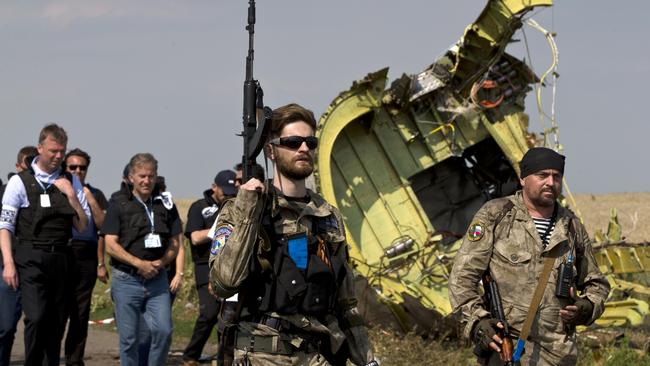Strongman Putin aims to shoot down quest for justice
PUTIN mounts a Soviet-style propoganda campaign.

JULIE Bishop’s words echoed around the world this week as she spoke from Australia’s seat at the UN Security Council. “The message from this council to those who were responsible for this atrocity is definitive; you will be held to account for your actions,” the Foreign Minister warned, her eyes flashing with anger.
It was a big promise driven by good intentions, but just more than a week since a missile shot Malaysian Airlines flight MH17 from the sky, there are growing fears justice may never be delivered to the 298 victims.
In the face of mounting international condemnation, Russian President Vladimir Putin has launched a Cold-War style propaganda campaign to challenge the West’s version about the fate of the Boeing 777. It is a campaign that seeks to weaken the political backlash against Russia and to ensure no court can bring a successful prosecution against those responsible for the crime.
Putin has employed his intelligence services and a compliant Russian media to provide an alternative narrative for the tragedy, to suggest to the world that the plane was shot down by Ukrainian forces, not pro-Russian separatists. Meanwhile, pro-Russian separatists continue to tamper with the plane’s wreckage in East Ukraine, progressively undermining the ability of investigators to glean answers.
Rather than step back in the face of international pressure, Putin has brazenly stepped up Russia’s involvement in eastern Ukraine since the crash, with US officials yesterday accusing Russia of firing artillery across its border at Ukrainian military positions.
Memorial: Tribute to MH17 victims
As one US intelligence official told a press briefing in Washington this week, “We are seeing a full-court press by the Russian government to instruct affiliated or friendly elements to manipulate the media environment to spread Russia’s version of the (MH17) story.”
Putin’s aim is to sow enough doubt in Washington’s version of events to soften the likely economic and political sanctions that are coming Russia’s way, and to fuel conspiracy theories to muddy the facts and undermine future legal prosecutions.
From Canberra’s viewpoint, Putin is seeking to shoot down its quest for justice for the 37 lost Australians (41 counting our permanent residents) because it would only spotlight his own government’s complicity in the tragedy.
As Tony Abbott put it, “after the crime comes the cover-up”, including “evidence tampering on an industrial scale”.
Putin’s move has sparked a quick response from the Obama administration, which countered this week by releasing some of its own intelligence to back its case that pro-Russian separatist rebels shot down the plane with a Russian-supplied SA-11 missile.
The world’s Cold War superpowers now find themselves fighting over the veracity of their own intelligence in a manner not seen since the weapons of mass destruction controversy in Iraq a decade ago.
Despite the heavy political focus on the need to launch a proper investigation at the crash scene, such an investigation is likely only to confirm what the world already knows — that the plane was shot down without warning by an SA-11 missile launched from eastern Ukraine.
The key contestable questions are: who fired the shot and who provided the missile system?
This can be answered only by secret satellite and signals intelligence complemented by real-time social media postings and radio intercepts when the plane went down.
This is why Russia this week moved to muddy these waters.
It held a bizarre Soviet-era style press conference in Moscow in which Russian army general Andrei Kartopolov and air force general Igor Makushev sat in front of a giant map and brandished aerial photos of what they claimed were Ukrainian Buk missile systems in the region where MH17 was shot down.
The Russians claimed that on the day the plane was destroyed, the Ukraine armed forces sent three or four Buk systems into the region. As evidence the generals produced photos that they claimed showed Buk systems in the area at the time, but these photos were indistinct and so lacking in geographical context as to be meaningless.
The Russians effectively were accusing the Americans and the Ukrainians of lying in their claim that no Ukrainian Buk systems were in the area at the time of the crash.
They then opened up a second possible theory, claiming Russian radar had detected a Ukrainian SU-25 fighter jet tracking MH17 at a distance of 3km to 5km at the time of the crash.
What was the Ukraine fighter doing in this region, the Russians asked, with the clear implication that this plane may have fired the fatal missile?
Once again, Russia was accusing Ukraine of lying in its claim that none of it warplanes were in the air at that time.
Both of these Russian narratives were damaging to Washington’s version of events, not because they were credible but because they were impossible to categorically refute without the US releasing highly classified satellite and signals intelligence, which would reveal to Moscow the extent of US surveillance capabilities along its border.
Russia knows this, which is why it goaded the US during the press conference, inviting Washington to release all of its satellite images and intelligence on the crash.
Putin’s counter-offensive was also aimed at his own people, to ensure that Russians blamed Ukraine, rather than pro-Russian separatists, for the tragedy.
The Russian media has helped push Putin’s version of events by also blaming Ukraine. Russia’s bestselling tabloid newspaper, Komsomolskaya Pravda, ran an opinion piece saying the passenger jet was downed by the Ukraine military, which believed it was a Russian plane, while an editorial in daily newspaper Nezavisimaya Gazeta said the plane crash was the “prelude to the start of a new Cold War”.
The pro-Russian population in eastern Ukraine is also being fed Russia’s version of events via Russian television, which is beamed into the area.
The US responded to Moscow’s press conference the following day by calling in journalists for a press briefing in Washington with three unnamed senior US intelligence officers who described Moscow’s claims as “desperate” propaganda.
But this Washington briefing revealed the strengths and the weakness in the case against the pro-Russian separatists and indeed against Putin himself.
The US officials produced a map, although not actual satellite images, of what Washington believes is the missile launch site near the village of Snizhe.
It produced aerial photos that showed a rapid military build-up in a Russian base in Rostov near the border during the past month.
The US officials then showed a series of photos taken on social media of what appeared to be a Buk system on the back of a truck passing through separatist-held villages near the launch site in the hours before the plane was destroyed.
They also showed social media pictures apparently travelling back to Russia through the Krasnodon area but said they couldn’t be certain when the missile system was brought into eastern Ukraine.
The officials said the CIA had analysed the voice intercepts of separatist leaders bragging about the downing of the plane and had concluded that they were authentic, contradicting Russia’s claim that they had been doctored.
And they pointed out that once the separatists realised the downed plane was a passenger jet, they deleted their previous boasts about shooting it down and about possessing a Buk system.
In short, the US has a powerful circumstantial case that pro-Russian separatists accidentally shot down MH17, most likely believing it to be a Ukrainian military jet and almost certainly using a Russian-supplied missile system.
It has ample evidence of Russian military assistance to pro-Russian separatists in the region and it knows those separatists have fired at, and downed, Ukrainian military planes during the past month, including two this week after the shooting down of MH17. It also knows that only the Russians could have supplied the separatists with a missile system capable of shooting down a passenger plane at 33,000 feet (10,000m).
“It’s a solid case that it’s an SA-11 that was fired from eastern Ukraine under conditions the Russians helped to create,” a US intelligence official said at the Washington briefing.
“There are two things we don’t know … who exactly pulled the trigger. We don’t have a name, a rank or a nationality. And we don’t know why.”
And this is where Bishop’s pledge to seek justice runs into trouble. If the available intelligence at this point does not come close to identifying the person or people responsible for mistakenly targeting the plane, then what are the prospects of identifying them now — in a war zone — against the wishes of the controlling separatists and Russia, then extraditing them and obtaining a legal conviction against them under international law?
“This is going to be one of the hardest prosecutions imaginable,” William Burke-White, a law professor and former policy adviser to then secretary of state Hillary Clinton, told The Washington Post. “Figuring out who actually launched the missile is going to be near to impossible, and any evidence that was probably there has probably been destroyed.”
Even though the tragedy would not have happened if Putin had not been lending missile systems to pro-Russian separatists, it will be difficult for an international court legally to blame Russia and Putin directly for the mistaken downing of the plane beyond the general point that its policies made such an act possible.
For someone to — in Bishop’s words — be held to account for this tragedy will be almost impossible while Russia and the separatists remain defiant.
The early signs are not good, and Australians may have to brace themselves for the prospect that those responsible for this horrendous crime will get away with murder.



